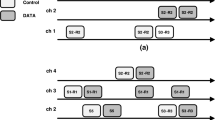Abstract
This paper presents DT-MAC, a dynamic TDMA based medium access control (MAC) protocol designed to offer collision-free transmissions while providing QoS guarantees for different services in scalable fully connected ad hoc networks. In DT-MAC, a new time frame structure which consists of synchronization, request, assignment and data slots is put forward. In each frame, the number of slots and their lengths are adaptively adjusted according to the number of nodes and their services in the network. Meanwhile, a distributed frame synchronization method is proposed to provide synchronization guarantee for the nodes and generate a manager node for each frame to dynamically allocate the slots according to the QoS requirements of different services. Besides, by introducing request slot, DT-MAC can make nodes join or leave the network without conflicts. Simulation results show that DT-MAC performs better in providing QoS guarantees and accommodating the change of network scale compared with conventional TDMA-based MAC protocols.














Similar content being viewed by others
References
Wang, N., & Lee, C. (2009). A reliable QoS aware routing protocol with slot assignment for mobile ad hoc networks. Journal of Network and Computer Applications, 32(6), 1153–1166.
Chlamtac, I., Conti, M., & Liu, J. (2003). Mobile ad hoc networking: imperatives and challenges. Ad Hoc Networks, 1(1), 13–64.
Niculescu, D., & Nath, B. (2003). DV based positioning in ad hoc networks. Telecommunication Systems, 22(1–4), 267–280.
Ergen, M., Lee, D., Sengupta, R., & Varaiya, P. (2003). Wireless token ring protocol-performance comparison with IEEE 802.11. In ISCC’03, 2, 710–715.
Ergen, M., Lee, D., Sengupta, R., & Varaiya, P. (2004). WTRP-wireless token ring protocol. IEEE Transactions on Vehicular Technology, 53(6), 1863–1881.
Bianchi, G. (2000). Performance analysis of the IEEE 802.11 distributed coordinated function. IEEE Journal on Selected Areas in Communications, 18(3), 535–547.
Li, Z., Nandi, S., & Gupta, A. K. (2005). ECS: an enhanced carrier sensing mechanism for wireless ad hoc networks. Computer Communications, 28(17), 1970–1984.
Bruhadeshwar, B., Kothapalli, K., & Pulla, I.R. (2010). A fully dynamic and self-stabilizing TDMA scheme for wireless ad-hoc networks. In AINA’10, 511–518.
Djukic, P., & Valaee, S. (2009). Delay aware link scheduling for multi-Hop TDMA wireless networks. IEEE/ACM Transaction on Networking, 17(3), 870–883.
Salonodis, T., & Tassiulas, L. (2004). Asynchronous TDMA ad hoc networks: scheduling and performance. European Transactions on Telecommunications, 15(4), 391–403.
Chlamtac, I., & Faragó, A. (1994). Making transmission schedules immune to topology changes in multihop packet radio networks. IEEE/ACM Transaction on Networking, 2(1), 23–29.
Chlamtac, I., Faragó, A., & Zhang, H. (1997). Time-spread multiple-access (TSMA) protocols for multihop mobile radio networks. IEEE/ACM Transaction on Networking, 5(6), 804–812.
Young, C.D. (1996). USAP: a unifying dynamic distributed multichannel TDMA slot assignment protocol. In IEEE MILCOM’96, 1, 235–239.
Young, C.D. (1999). USAP multiple access: dynamic resource allocation for mobile multihop multichannel wireless networking. In IEEE MILCOM’99, 1, 271–275.
Kanzaki, A., Uemukai, T., Hara, T., & Nishio, S. (2003). Dynamic TDMA slot assignment in ad hoc networks. In AINA’03, 330–339.
Kanzaki, A., Hara, T., & Nishio, S. (2005). An adaptive TDMA slot assignment protocol in ad hoc sensor networks. In ACM SAC 2005, 1160–1165.
Park, S., & Sy, D. (2008). Dynamic control slot scheduling algorithms for TDMA based mobile ad hoc networks. In IEEE MILCOM 2008, 1–7.
Bao, L., & Garcia-Luna-Aceves, J. J. (2001). A new approach to channel access scheduling for ad hoc networks. In 7th annual international conference on Mobile computing and networking (MobiCom’01).
Zhu, C., & Corson, M. S. (2001). A five-phase reservation protocol (FPRP) for mobile ad hoc networks. Wireless Networks, 7(4), 371–384.
Zhu, C., & Corson, M. S. (2000). An evolutionary-TDMA scheduling protocol (E-TDMA) for mobile ad hoc networks. In ATIRP 2000.
Kanzaki, A., Hara, T., & Nishio, S. (2007). An efficient TDMA slot assignment protocol in mobile ad hoc networks. In SAC’07, 891–895.
Wu, M. (2007). Dynamic frame length channel assignment in wireless multihop ad hoc networks. Computer Communications, 30(18), 3832–3840.
Cui, M., Yin, X., Nie, Y., Zhang, J., & Cao, L. (2008). An evolutionary dynamic slots assignment algorithm based on P-TDMA for mobile ad hoc networks. In ICCS 2008, 579–582.
Li, W., Wang, S., & Wei, B. (2008). An evolutionary topology unaware TDMA MAC protocol for ad hoc networks. In ICC’08, 4825–4829.
Myers, A. D., Záruba, G. V., & Syrotiuk, V. R. (2002). An adaptive generalized transmission protocol for ad hoc networks. Mobile Networks and Applications, 7(6), 493–502.
Chlamtac, I., Farago, A., Myers, A.D., Syrotiuk, V.R., & Zaruba, G. (1999). ADAPT: a dynamic self-adjusting media access control protocol for ad hoc networks. In GLOBECOM’99, 1a, 11–15.
Chlamtac, I., Myers, A. D., Syrotiuk, V. R., & Zaruba, G. (2000). An adaptive medium access control (MAC) protocol for reliable broadcast in wireless networks. In ICC 2000, 3, 1692–1696.
Sharp, B.A., Grindrod, E.A., & Camm, D.A. (1995). Hybrid TDMA/CDMA protocol self-managing packet radio networks. In IEEE ICUPC’95, 929–933.
Boggia, G., Camarda, P., Grieco, L.A., & Zacheo, G. (2008). An experimental evaluation on using TDMA over 802.11 MAC for wireless networked control systems. In ETFA 2008, 1157–1160.
Koutsonikolas, D., Salonidis, T., Lundgren, H., LeGuyadec, P., Hu, Y.C., & Sheriff, I. (2008). TDM MAC protocol design and implementation for wireless mesh networks. In ACM CoNEXT.
Panigrahi, D., & Raman, B. (2009). TDMA scheduling in long-distance WiFi networks. In INFOCOM 2009, 2931–2935.
http://www.qualnet.com/ and related web pages it linked.
Scalable Network Technologies Inc. (March, 2008). QualNet 4.5 Programmer’s Guide.
Acknowledgments
This work is supported in part by National Natural Science Foundation of China (Nos. 61100195, 61003116), Specialized Research Fund for the Doctoral Program of Higher Education of China (No. 20103218120022), Natural science foundation of Jiangsu Province of China (No. BK2010263), Fundation of Graduate Innovation Center in NUAA (No. kfjj120113), and Fundamental Research Funds for the Central Universities of China (No. NZ2012011).
Author information
Authors and Affiliations
Corresponding author
Rights and permissions
About this article
Cite this article
Lei, L., Cai, S., Luo, C. et al. A dynamic TDMA-based MAC protocol with QoS guarantees for fully connected ad hoc networks. Telecommun Syst 60, 43–53 (2015). https://doi.org/10.1007/s11235-014-9920-5
Published:
Issue Date:
DOI: https://doi.org/10.1007/s11235-014-9920-5




